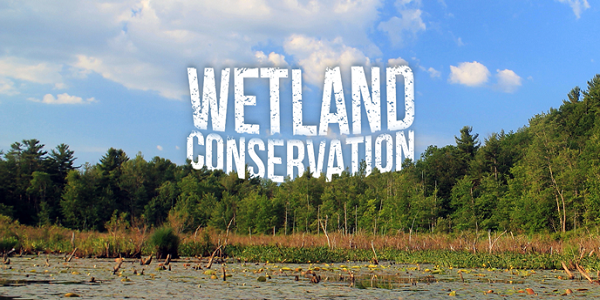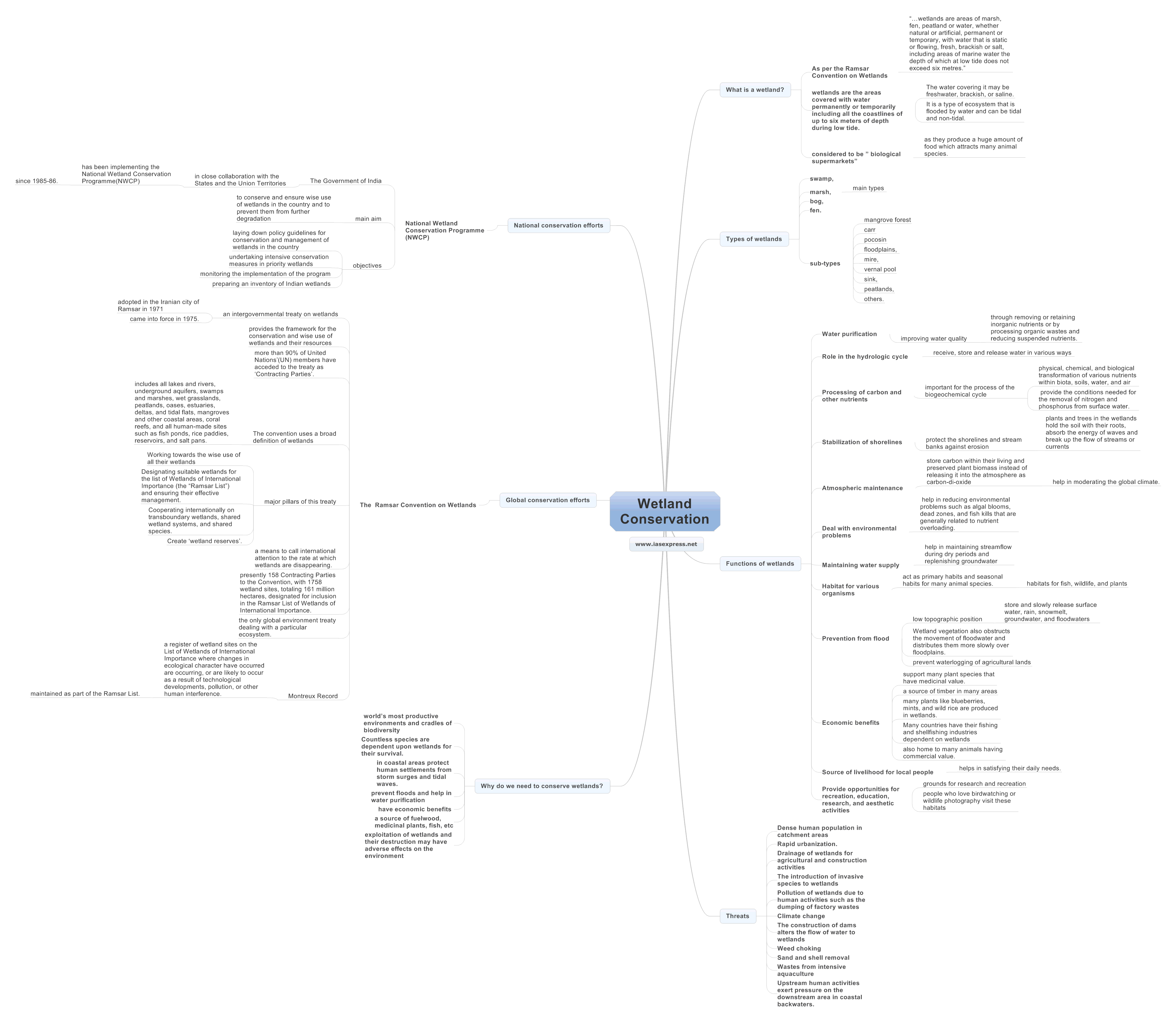Wetland Conservation – Importance, Threats and Way Forward

With the frequent addition of new names to the list of wetlands in India, the concern for wetlands is increasing simultaneously all over the world. Climate activists and climate organizations raise their voices from time immemorial to protect wetlands. Wetlands prove to be a playing a very important part in maintaining the ecological balance in the environment. They harbor several plant and animal species and help in their prevention from extinction. They are also useful for human beings as they prevent floods and serve as a great source for recycling organic waste. Given the importance of wetlands, it has become important for us to look into various issues involved in wetland conservation and suggest measures to protect them.
This topic of “Wetland Conservation – Importance, Threats and Way Forward” is important from the perspective of the UPSC IAS Examination, which falls under General Studies Portion.
What is a wetland?
As per the Ramsar Convention on Wetlands, “…wetlands are areas of marsh, fen, peatland or water, whether natural or artificial, permanent or temporary, with water that is static or flowing, fresh, brackish or salt, including areas of marine water the depth of which at low tide does not exceed six metres.”
In other words, wetlands are the areas covered with water permanently or temporarily including all the coastlines of up to six meters of depth during low tide. The water covering it may be freshwater, brackish, or saline. It is a type of ecosystem that is flooded by water and can be tidal and non-tidal. They are considered to be ” biological supermarkets” as they produce a huge amount of food which attracts many animal species.
Types of wetlands
The main types of wetlands include swamp, marsh, bog, and fen. The sub-types include mangrove forest, carr, pocosin, floodplains, mire, vernal pool, sink, peatlands, and others.
Functions of wetlands
- Water purification – They help in improving water quality through removing or retaining inorganic nutrients or by processing organic wastes and reducing suspended nutrients.
- Role in the hydrologic cycle – Wetlands receive, store and release water in various ways and thus play a very important role in the hydrologic cycle.
- Processing of carbon and other nutrients – Wetlands are very important for the process of the biogeochemical cycle which involves the physical, chemical, and biological transformation of various nutrients within biota, soils, water, and air. They provide the conditions needed for the removal of nitrogen and phosphorus from surface water.
- Stabilization of shorelines – As they are generally located at the margins of lakes, bays, rivers, and oceans, they protect the shorelines and stream banks against erosion. The plants and trees in the wetlands hold the soil with their roots, absorb the energy of waves and break up the flow of streams or currents.
- Atmospheric maintenance – They store carbon within their living and preserved plant biomass instead of releasing it into the atmosphere as carbon-di-oxide and thus help in moderating the global climate.
- Deal with environmental problems – Wetlands help in reducing environmental problems such as algal blooms, dead zones, and fish kills that are generally related to nutrient overloading.
- Maintaining water supply – Wetlands help in maintaining streamflow during dry periods and replenishing groundwater thus maintaining the water supply.
- Habitat for various organisms – Wetlands act as habitats for fish, wildlife, and plants. Many species of plants and animals depend on wetlands for their survival. Wetlands act as primary habits and seasonal habits for many animal species.
- Prevention from flood – As they have a low topographic position, they store and slowly release surface water, rain, snowmelt, groundwater, and floodwaters. Wetland vegetation also obstructs the movement of floodwater and distributes them more slowly over floodplains. Wetlands also prevent waterlogging of agricultural lands.
- Economic benefits – Wetlands support many plant species that have medicinal value. They are a source of timber in many areas. Similarly, many plants like blueberries, mints, and wild rice are produced in wetlands. Many countries have their fishing and shellfishing industries dependent on wetlands. Wetlands are also home to many animals having commercial value.
- Source of livelihood for local people – Wetlands also serve the needs of local people living in that area. Many people depend on wetlands for various things that have commercial value and it thus helps in satisfying their daily needs.
- Provide opportunities for recreation, education, research, and aesthetic activities – Wetlands act as grounds for research and recreation. Many people who love birdwatching or wildlife photography visit these habitats to have a view of various species.
Threats
- Dense human population in catchment areas.
- Rapid urbanization.
- Drainage of wetlands for agricultural and construction activities causes harm to wetlands.
- The introduction of invasive species to wetlands damages the wetland ecosystems.
- Pollution of wetlands due to human activities such as the dumping of factory wastes is harming the flora and fauna of wetland ecosystems.
- Climate change is another major factor that acts as a threat to wetlands.
- The construction of dams alters the flow of water to wetlands thus altering the healthy status of wetlands.
- Weed choking is another cause of concern for wetlands.
- Sand and shell removal is harming the wetlands.
- Wastes from intensive aquaculture are another threat.
- Upstream human activities exert pressure on the downstream area in coastal backwaters.
Why do we need to conserve wetlands?
Wetlands have several benefits for the environment. They are the world’s most productive environments and cradles of biodiversity. Countless species are dependent upon wetlands for their survival. Wetlands in coastal areas protect human settlements from storm surges and tidal waves. Wetlands prevent floods and help in water purification. They have economic benefits as well as they are a source of fuelwood, medicinal plants, fish, etc. The exploitation of wetlands and their destruction may have adverse effects on the environment and thus there is a need to protect them.
Global conservation efforts
The Ramsar Convention on Wetlands is an intergovernmental treaty on wetlands adopted in the Iranian city of Ramsar in 1971 and came into force in 1975. It is a treaty that provides the framework for the conservation and wise use of wetlands and their resources. Since its adoption, more than 90% of United Nations’(UN) members have acceded to the treaty as ‘Contracting Parties’.
The convention uses a broad definition of wetlands and includes all lakes and rivers, underground aquifers, swamps and marshes, wet grasslands, peatlands, oases, estuaries, deltas, and tidal flats, mangroves and other coastal areas, coral reefs, and all human-made sites such as fish ponds, rice paddies, reservoirs, and salt pans.
The major pillars of this treaty to which the ‘Contracting Parties’ need to adhere to include:-
- Working towards the wise use of all their wetlands
- Designating suitable wetlands for the list of Wetlands of International Importance (the “Ramsar List”) and ensuring their effective management.
- Cooperating internationally on transboundary wetlands, shared wetland systems, and shared species.
- Create ‘wetland reserves’.
The Convention acts as a means to call international attention to the rate at which wetlands are disappearing. There are presently 158 Contracting Parties to the Convention, with 1758 wetland sites, totaling 161 million hectares, designated for inclusion in the Ramsar List of Wetlands of International Importance. This is the only global environment treaty dealing with a particular ecosystem.
Montreux Record
Montreux Record under the Convention is a register of wetland sites on the List of Wetlands of International Importance where changes in ecological character have occurred, are occurring, or are likely to occur as a result of technological developments, pollution, or other human interference. It is maintained as part of the Ramsar List.
National conservation efforts
India is a rich nation in terms of the presence of wetlands. The wetlands in India are distributed all over ranging from the Himalayas to the Deccan in varied topography and climate regimes. India has a large number of wetlands, of which some are inland and some are coastal. Wetlands occupy a major portion of the country’s area of which most are under paddy cultivation. Natural wetlands in India consist of high altitude wetlands in the Himalayas; flood plains of the major river systems; saline and temporary wetlands of the arid and semi-arid regions; coastal wetlands such as lagoons, backwaters, estuaries, mangroves, swamps, and coral reefs, and so on. In addition to these natural wetlands, a large number of man-made wetlands, which have resulted from the needs of irrigation, water supply, electricity, fisheries, and flood control, are substantial in number. These wetlands can be classified into different categories based on their origin, vegetation, nutrient status, and thermal characteristics. Indian wetlands are generally dominated by mangrove vegetation.
National Wetland Conservation Programme (NWCP)
The Government of India has been implementing the National Wetland Conservation Programme(NWCP) in close collaboration with the States and the Union Territories since 1985-86. The main aim of the program is to conserve and ensure wise use of wetlands in the country and to prevent them from further degradation. The objectives of the Scheme include laying down policy guidelines for conservation and management of wetlands in the country; undertaking intensive conservation measures in priority wetlands; monitoring the implementation of the program; and preparing an inventory of Indian wetlands.
Way forward
The conservation of wetlands needs management of environmental needs with a holistic approach. There should be people’s participation and developmental activities should consider the immediate stress on the biota and the local community residing there. Legal instruments will not merely help in serving the purpose rather we need to involve all the stakeholders to conserve such ecosystems. The management programs should include sustainable measures so that those who are dependent on it do not suffer and biodiversity is protected. There is a need to adopt scientific, technical, and socio-economic cooperation to conserve the wetlands. Integrated management with a collaborative approach can pave the way for attaining the goal.
Practise question
- Why is there a need for the conservation of wetlands? What are the threats to wetlands? Suggest measures to protect wetlands.
- http://moef.gov.in/national-wetland-conservation-programme-nwcp/
- https://www.ramsar.org/about/the-importance-of-wetlands
- https://geographyandyou.com/wetland-conservation/
- http://cas.umt.edu/watershedclinic/links/clarkfork/wetlands/threatstowetlands.htm
- http://wgbis.ces.iisc.ernet.in/energy/water/proceed/proceedings_text/section6/paper2/section6paper2.htm
- https://www.epa.gov/sites/production/files/2016-02/documents/wetlandfunctionsvalues.pdf


